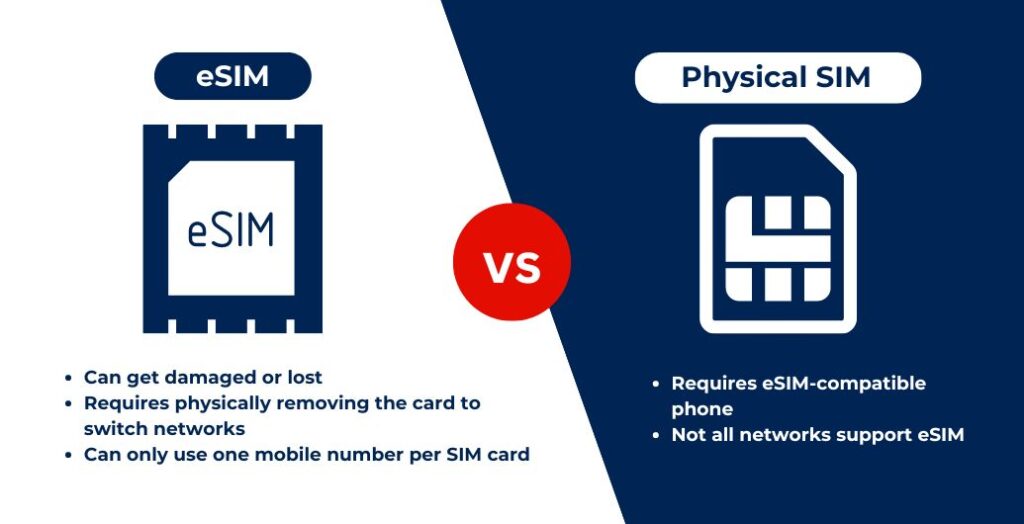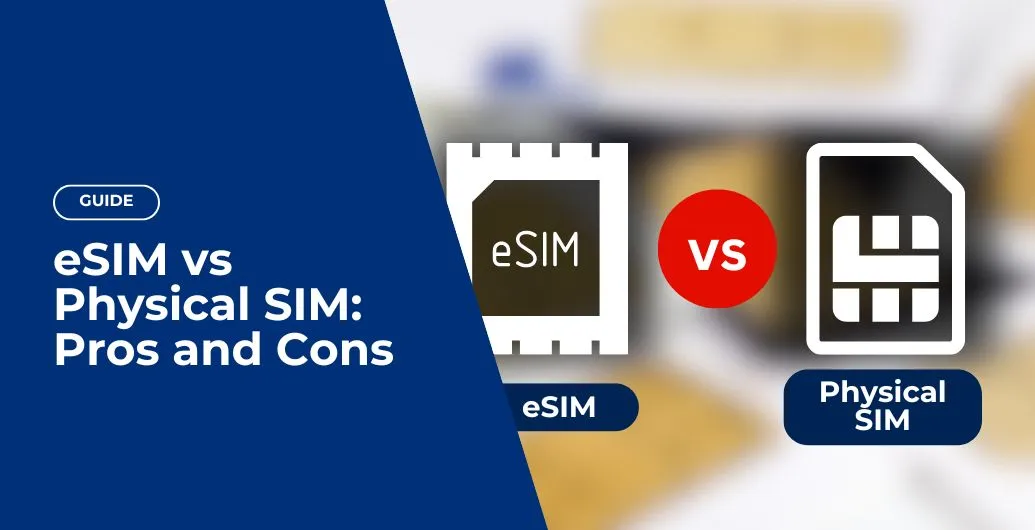Estimated reading time: 6 minutes
For years, physical Subscriber Identity Module (SIM) cards have been the standard for accessing mobile networks. But now, there’s a new player on the block. eSIMs (embedded SIMs) apparently provide better convenience and security for users. So, if you’re thinking of making the switch or just simply curious, we’ll discuss the pros and cons of an eSIM vs physical sim card to see how they’ll impact your connectivity.
Table of contents
How does an eSIM work?
Unlike the traditional physical SIM card, you can reprogram an eSIM at any time. It contains software that’s downloaded to a pre-installed microchip in your mobile phone. However, the card functions similarly to a traditional SIM card, where you can make a call or send a text message.
What’s the difference between an eSIM and a physical SIM card?
Although the main function of both cards is to connect you to a mobile network, you can find differences between the two. For instance, you can insert and remove a physical SIM card from your phone while an eSIM is embedded directly into your device.
Additionally, an eSIM can store multiple profiles or mobile numbers in one card, so you can easily switch between carriers through your phone settings. Depending on your device, you can also use up to two profiles or mobile numbers at a time, so you can stay connected on both networks.
Also Read: eSIMs in the Philippines: Benefits, Activation, and Best Options
eSIM vs physical SIM: Pros and Cons of each
Here’s a quick breakdown of the pros and cons of each technology:

Advantages of a Physical SIM
- Reliable and familiar
- Wide network and phone compatibility
Disadvantages of a Physical SIM
- Can get damaged or lost
- Requires physically removing the card to switch networks
- Can only use one mobile number per SIM card

Advantages of an eSIM
- Easier to switch between networks with one card
- Ability to simultaneously use a physical and eSIM in one device
- Eliminates SIM damage or loss
- Able to use two mobile numbers in one phone
- Can install multiple eSIMS in one smartphone
- No need to get a secondary phone for data use
Disadvantages of an eSIM
- Requires eSIM-compatible phone
- Not all networks support eSIM
Where to buy eSIM in the Philippines
Now that you know how an eSIM differs from a physical card, you might wonder, “is eSIM available in the Philippines?”
Yes, you can get an eSIM in the Philippines. Globe was the first mobile network to offer them before Smart and TNT followed suit. For Globe, you can only get a Prepaid eSIM through their GlobeOne app, while you can get a Smart or TNT card from their website’s store or app.
How to set up eSIM
Whether you’re thinking of switching or already have one in your possession, here are the steps you need to take to set up an eSIM:
Globe
For iPhone users:
- Connect your smartphone to the internet
- Go to Settings and click “Cellular”
- Click “Set Up Cellular” or “Add eSIM”
- Go to the QR Code scanner
- Scan the eSIM digital QR code
- Click “Add Cellular Plan”
- Disregard the pop-up message and click “OK”
- The eSIM will be displayed with your mobile number, and you’re good to go
For Android users:
- Connect your device to the internet
- Go to Settings and click “Connections”
- Click “Add Mobile Plan, then click “Scan Carrier QR Code”
- Scan your eSIM digital QR code, and click “Confirm”
- The eSIM will display your mobile number, and you’re done
Smart and TNT
You can install your Smart or TNT eSIM by scanning the QR code that the network sends to your email. Just make sure you have a stable internet connection so you can complete the process smoothly. We also recommend you keep your QR in case you need to reinstall your eSIM on your device.
If you don’t receive an email containing your QR code, Smart suggests you send them an email at m.me/SmartCommunications or X @SMARTCares: with your email address and Order Reference Number (optional).
Alternatively, you can also install your eSIM using your phone’s SIM manager settings through the following steps:
For Apple users:
- Connect your phone to the internet
- Go to Settings and tap on “Cellular Network”
- Click “Add Cellular Plan” or “Add eSIM”
- Your phone’s camera will automatically launch
- You will be prompted that you have already downloaded the eSIM
For Samsung users:
- Connect your device to the internet
- Go to Settings and click on the “Connections” menu
- Select “SIM Card Manager” and “Add Mobile Plan”
- Click on “Add Using QR Code”
- Scan the QR code
- Select “Add Cellular Plan”
- Click on “OK” to turn on your new mobile plan
- Your new eSIM profile will be displayed
For Huawei users:
- Connect to the internet
- Go to Settings and select “Mobile Network”
- Click “SIM Management”
- Select “SIM 2 Settings” and click on “eSIM”
- Click “Add eSIM”
- Scan the QR Code
- Click “Add this eSIM”
- Your new eSIM profile will be displayed
Also Read: GUIDE: How to Deactivate Sim Card
Is eSIM worth Switching?
The choice between an eSIM vs. physical SIM card ultimately boils down to your needs and preferences. We recommend you assess your connectivity and data use to determine if you need to switch to an eSIM or stay with your trusty physical SIM card.
An eSIM provides you with more convenience since you can easily switch between networks with just one card. So, we recommend you upgrade if you prefer to use multiple networks or mobile numbers but don’t want to carry around different phones. The same way goes if you tend to use a secondary phone and SIM card for data use. Instead of having two of each, an eSIM will let you access your preferred network’s data promo in just one mobile device.
Meanwhile, a physical SIM card offers greater network and mobile device compatibility, but it also has its own disadvantages. If you’re curious to see how an eSIM works in the Philippines, you can try one from Globe, Smart, or TNT!
Frequently Asked Questions (FAQs)
If you want to know more about eSIMs, here are answers to frequently asked questions:
Is eSIM better than a physical SIM card?
It depends on your needs, but an eSIM has added advantages over a physical card, such as added security, smaller size, and the ability to store multiple mobile profiles. You can also refer to our guide above for a more detailed breakdown of its pros and cons.
Why is eSIM not popular?
One of the reasons eSIMs are not as popular as physical cards is that they’re only compatible with newer phone models. Another is that consumers are hesitant to switch to an eSIM because they’re not aware it exists or are not familiar with its features.
Does eSIM work without the internet?
Yes, an eSIM works similarly to a physical SIM card, so you can send a message or make a call without the internet. The only time you need a WiFi or data connection is when you activate the eSIM for the first time.
Sources: (1), (2), (3), (4), (5)
Keep Reading: GUIDE: How Do I Know if My Sim is Already Registered?

Leave a Reply